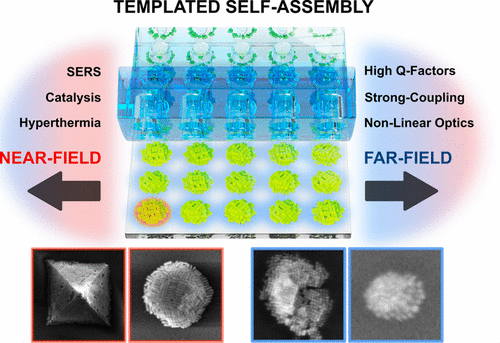当前位置:
X-MOL 学术
›
Acc. Mater. Res.
›
论文详情
Our official English website, www.x-mol.net, welcomes your feedback! (Note: you will need to create a separate account there.)
Templated Colloidal Self-Assembly for Lattice Plasmon Engineering
Accounts of Materials Research ( IF 14.6 ) Pub Date : 2021-08-12 , DOI: 10.1021/accountsmr.1c00106 Leonardo Scarabelli 1 , David Vila-Liarte 2, 3 , Agustín Mihi 1 , Luis M. Liz-Marzán 2, 3, 4
Accounts of Materials Research ( IF 14.6 ) Pub Date : 2021-08-12 , DOI: 10.1021/accountsmr.1c00106 Leonardo Scarabelli 1 , David Vila-Liarte 2, 3 , Agustín Mihi 1 , Luis M. Liz-Marzán 2, 3, 4
Affiliation

|
Over the past 30 years, the engineering of plasmonic resonances at the nanoscale has progressed dramatically, with important contributions in a variety of different fields, including chemistry, physics, biology, engineering, and medicine. However, heavy optical losses related to the use of noble metals for the fabrication of plasmonic structures hindered their application in various settings. Recently, an answer to these long-lasting issues emerged in the use of lattice plasmon resonances (LPRs, also called surface lattice resonances), bringing new excitement in the field of plasmonics. Specifically, the organization of plasmonic nanoparticles into ordered arrays enables far-field coupling of the scattered light exploiting the diffraction modes of the array, generating plasmonic resonances with bandwidths as narrow as a few nanometers, corresponding to an increase of over 10-fold in the quality factors compared to localized plasmon resonances. As such, LPRs offer new opportunities to harness light–matter interactions at the nanoscale, while generating renewed interest in the self-assembly of colloidal metal nanoparticles, as a scalable approach to the preparation of such plasmonic arrays. Templated self-assembly emerged as one of the most versatile approaches, being compatible with soft-lithographic techniques such as nanoimprint lithography and amenable to a variety of materials, colloids, and solvents. Templated self-assembly additionally allows the preparation of arrays where the repeating units are composed of multiple self-assembled nanoparticles (i.e., plasmonic clusters). In this system, near-field coupling can be finely tuned, thereby showing promising results in biosensing, catalysis, or plasmonic heating. In this Account, we review the preparation of ordered arrays of clusters of plasmonic nanoparticles. We present various aspects involved in the templated self-assembly of colloidal nanoparticles, with the aim of achieving at the same time close-packed structures within each cavity of the template, and uniform deposition over a large area. We then analyze the optical properties of the prepared substrates. The preparation of hierarchical structures and the possibility of tuning both the internal structure of the cluster and their organization into arrays with different lattice parameters enable control over both near-field and far-field plasmonic coupling. This unique feature of such substrates makes it possible to exploit the interplay between these two types of coupling, for the preparation of versatile functional substrates, expanding the possibilities for the integration of plasmonic arrays into functional devices for various applications. A well-established example is their use for surface-enhanced Raman scattering. On the other hand, optimization of far-field coupling provides access to plasmonic cavities for lasing or refractive index sensing. Despite two decades of fervid scientific research, the preparation and engineering of plasmonic arrays remains a relevant topic, and many directions remain largely unexplored. We conclude with a collection of perspectives and challenges that we find particularly stimulating toward future developments of the field.
中文翻译:

用于晶格等离子体工程的模板化胶体自组装
在过去的 30 年中,纳米级等离子体共振工程取得了巨大进展,在化学、物理学、生物学、工程学和医学等各种不同领域都做出了重要贡献。然而,与使用贵金属制造等离子体结构相关的严重光学损失阻碍了它们在各种环境中的应用。最近,在使用晶格等离子体共振(LPR,也称为表面晶格共振)时出现了对这些长期存在的问题的答案,为等离子体领域带来了新的兴奋。具体而言,将等离子体纳米粒子组织成有序阵列,利用阵列的衍射模式实现散射光的远场耦合,产生带宽窄至几纳米的等离子体共振,与局部等离子体共振相比,质量因子增加了 10 倍以上。因此,LPR 提供了在纳米尺度上利用光-物质相互作用的新机会,同时重新引起了人们对胶体金属纳米粒子自组装的兴趣,作为制备此类等离子体阵列的可扩展方法。模板化自组装成为最通用的方法之一,与软光刻技术(如纳米压印光刻)兼容,并适用于各种材料、胶体和溶剂。模板化自组装还允许制备阵列,其中重复单元由多个自组装纳米粒子组成(LPR 为在纳米尺度上利用光-物质相互作用提供了新的机会,同时对胶体金属纳米粒子的自组装产生了新的兴趣,作为制备此类等离子体阵列的可扩展方法。模板化自组装成为最通用的方法之一,与软光刻技术(如纳米压印光刻)兼容,并适用于各种材料、胶体和溶剂。模板自组装还允许制备阵列,其中重复单元由多个自组装纳米粒子组成(LPR 为在纳米尺度上利用光-物质相互作用提供了新的机会,同时对胶体金属纳米粒子的自组装产生了新的兴趣,作为制备此类等离子体阵列的可扩展方法。模板化自组装成为最通用的方法之一,与软光刻技术(如纳米压印光刻)兼容,并适用于各种材料、胶体和溶剂。模板化自组装还允许制备阵列,其中重复单元由多个自组装纳米粒子组成(模板化自组装成为最通用的方法之一,与软光刻技术(如纳米压印光刻)兼容,并适用于各种材料、胶体和溶剂。模板化自组装还允许制备阵列,其中重复单元由多个自组装纳米粒子组成(模板化自组装成为最通用的方法之一,与软光刻技术(如纳米压印光刻)兼容,并适用于各种材料、胶体和溶剂。模板化自组装还允许制备阵列,其中重复单元由多个自组装纳米粒子组成(IE.,等离子簇)。在该系统中,可以对近场耦合进行微调,从而在生物传感、催化或等离子体加热方面显示出有希望的结果。在这个帐户中,我们回顾了等离子体纳米粒子簇有序阵列的制备。我们介绍了胶体纳米粒子模板化自组装涉及的各个方面,目的是同时在模板的每个腔内实现密堆积结构,并在大面积上均匀沉积。然后我们分析制备的基板的光学特性。分层结构的制备以及将簇的内部结构及其组织调整为具有不同晶格参数的阵列的可能性能够控制近场和远场等离子体耦合。这种基板的这一独特特征使得利用这两种耦合类型之间的相互作用成为可能,用于制备多功能的功能基板,扩大了将等离子体阵列集成到用于各种应用的功能器件中的可能性。一个成熟的例子是它们用于表面增强拉曼散射。另一方面,远场耦合的优化为激光或折射率传感提供了进入等离子体腔的途径。尽管经过了二十年的热烈科学研究,等离子体阵列的制备和工程仍然是一个相关的主题,许多方向在很大程度上仍未得到探索。我们总结了一系列观点和挑战,我们发现这些观点和挑战对这个领域的未来发展特别有启发性。
更新日期:2021-09-24
中文翻译:

用于晶格等离子体工程的模板化胶体自组装
在过去的 30 年中,纳米级等离子体共振工程取得了巨大进展,在化学、物理学、生物学、工程学和医学等各种不同领域都做出了重要贡献。然而,与使用贵金属制造等离子体结构相关的严重光学损失阻碍了它们在各种环境中的应用。最近,在使用晶格等离子体共振(LPR,也称为表面晶格共振)时出现了对这些长期存在的问题的答案,为等离子体领域带来了新的兴奋。具体而言,将等离子体纳米粒子组织成有序阵列,利用阵列的衍射模式实现散射光的远场耦合,产生带宽窄至几纳米的等离子体共振,与局部等离子体共振相比,质量因子增加了 10 倍以上。因此,LPR 提供了在纳米尺度上利用光-物质相互作用的新机会,同时重新引起了人们对胶体金属纳米粒子自组装的兴趣,作为制备此类等离子体阵列的可扩展方法。模板化自组装成为最通用的方法之一,与软光刻技术(如纳米压印光刻)兼容,并适用于各种材料、胶体和溶剂。模板化自组装还允许制备阵列,其中重复单元由多个自组装纳米粒子组成(LPR 为在纳米尺度上利用光-物质相互作用提供了新的机会,同时对胶体金属纳米粒子的自组装产生了新的兴趣,作为制备此类等离子体阵列的可扩展方法。模板化自组装成为最通用的方法之一,与软光刻技术(如纳米压印光刻)兼容,并适用于各种材料、胶体和溶剂。模板自组装还允许制备阵列,其中重复单元由多个自组装纳米粒子组成(LPR 为在纳米尺度上利用光-物质相互作用提供了新的机会,同时对胶体金属纳米粒子的自组装产生了新的兴趣,作为制备此类等离子体阵列的可扩展方法。模板化自组装成为最通用的方法之一,与软光刻技术(如纳米压印光刻)兼容,并适用于各种材料、胶体和溶剂。模板化自组装还允许制备阵列,其中重复单元由多个自组装纳米粒子组成(模板化自组装成为最通用的方法之一,与软光刻技术(如纳米压印光刻)兼容,并适用于各种材料、胶体和溶剂。模板化自组装还允许制备阵列,其中重复单元由多个自组装纳米粒子组成(模板化自组装成为最通用的方法之一,与软光刻技术(如纳米压印光刻)兼容,并适用于各种材料、胶体和溶剂。模板化自组装还允许制备阵列,其中重复单元由多个自组装纳米粒子组成(IE.,等离子簇)。在该系统中,可以对近场耦合进行微调,从而在生物传感、催化或等离子体加热方面显示出有希望的结果。在这个帐户中,我们回顾了等离子体纳米粒子簇有序阵列的制备。我们介绍了胶体纳米粒子模板化自组装涉及的各个方面,目的是同时在模板的每个腔内实现密堆积结构,并在大面积上均匀沉积。然后我们分析制备的基板的光学特性。分层结构的制备以及将簇的内部结构及其组织调整为具有不同晶格参数的阵列的可能性能够控制近场和远场等离子体耦合。这种基板的这一独特特征使得利用这两种耦合类型之间的相互作用成为可能,用于制备多功能的功能基板,扩大了将等离子体阵列集成到用于各种应用的功能器件中的可能性。一个成熟的例子是它们用于表面增强拉曼散射。另一方面,远场耦合的优化为激光或折射率传感提供了进入等离子体腔的途径。尽管经过了二十年的热烈科学研究,等离子体阵列的制备和工程仍然是一个相关的主题,许多方向在很大程度上仍未得到探索。我们总结了一系列观点和挑战,我们发现这些观点和挑战对这个领域的未来发展特别有启发性。

























 京公网安备 11010802027423号
京公网安备 11010802027423号